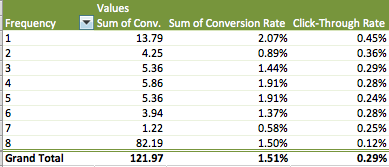Remarketing is, hands down, one of the most powerful tools available to us in PPC. So it can be a little surprising when we get asked “Does Remarketing really work, or is it just annoying your potential customers?” That doesn’t mean that it’s a stupid question though – just one that us long-time account managers might take for granted. So with that in mind, today we’re going to answer that question: Does Remarketing really work? If so, how well does it work? And… is it annoying?
Question 1: Does Remarketing Work?
Yes. Full stop. If you can use Remarketing, you should. I have a few accounts in which Remarketing isn’t an option due to the nature of the products. It’s one of the most infuriating lost opportunities I can think of when it comes to account management. It lets you take advantage of all of your site traffic (which comes pre-qualified since they’ve already shown an interest in your site), and it provides you with cheaper clicks and conversions.
Question 2: How Well Does Remarketing Work?
This is an entirely different question, and one that depends quite a bit on the nature of your business – your sales cycle, conversion goals (ecommerce v. lead gen), and how much time you have to create detailed Audience lists to maximize your efficiency.
However, to detail the benefits of Remarketing, we’ll do a miniature case study using some data from an active account. I’ve broken down the account statistics by campaign type detailing their performance over the last six months. To start, here’s a comparison between our Search and Remarketing campaigns:

Now, this isn’t an entirely fair comparison, as we’re looking at two entirely different campaign types. The CTR isn’t comparable, and in reality, these two work in concert with one another to fuel the great performance behind our Remarketing efforts. But it’s still telling in that the Remarketing campaign has a 22% cheaper Average Cost Per Click. This advantage, along with the slightly higher Conversion Rate amounts to a 25% lower Cost Per Conversion in comparison to our Search campaigns.
For another entirely-unfair comparison (just unfair for different reasons, i.e. performance), let’s take a look at Remarketing versus our regular Display efforts:

Now, a couple of caveats: the display campaigns were introduced only four months ago, hence the lower impression and click totals. Our display campaigns also feature a markedly lower Cost Per Click – but this advantage doesn’t translate to a better Cost Per Conversion, as the Conversion Rate is so far below par for this account.
Both the Click Through Rate and Conversion Rate are indicative of the power behind Remarketing: by targeting the users who’ve already visited your site, you’re targeting an audience who’s more likely to both click and convert based on your advertising efforts. Especially in comparison to your broader Display advertising campaign options.
Here’s the bottom line: for this account, Remarketing accounted for 16.61% of all conversions over the past six months, at only 12.93% of the total cost. It has only 81.36% of the average click cost, and only 77.82% of the average conversion cost. Of all campaign types in this account, it also had the highest conversion rate. This is a fairly conservative account, so I’m positive that there are others out there making even better use of this tactic.
In short, do Remarketing.
Question 3: Is Remarketing Annoying?
Maybe. This depends entirely on your user base and how well you know them. Most people find Remarketing pretty innocuous. But some people, especially for high-profile and/or prestigious brands, may find that excessive Remarketing can be detrimental if your overall goal is brand awareness. We’ve actually had clients who’ve received complaints about excessive Remarketing, and I quote, “devaluing your brand”. So it can definitely be a concern.
The best way to decipher this, outside of direct customer interaction, is to examine the Reach and Frequency Report found in the Dimensions tab. You can throw in some extra conversion and click data to determine if you’re seeing diminishing returns – i.e. annoying your customers. Going back to our previous case study, here’s that data for our Remarketing campaigns over the last six months:

So, looking at this, there are a few takeaways:
- Click-Through Rate shows definite diminishing returns once we hit that “8 or more” frequency threshold.
- Conversion Rate, though? Still going strong.
Try this same analysis on your own Remarketing campaign and see if you might need to institute Frequency capping (as detailed here).
One thing we’ve run in to in the past, though: if you have multiple Remarketing campaigns that use lists that aren’t mutually exclusive, you could end up double-serving – which will definitely annoy your customers. Until I saw a screenshot of that exact occurrence today, I would have sworn that it was impossible.
What about you, PPC Heroes and Heroines? Feel like sharing the love for Remarketing? Have you annoyed your customers? Let us know in the comments and, as always, thanks for reading!




